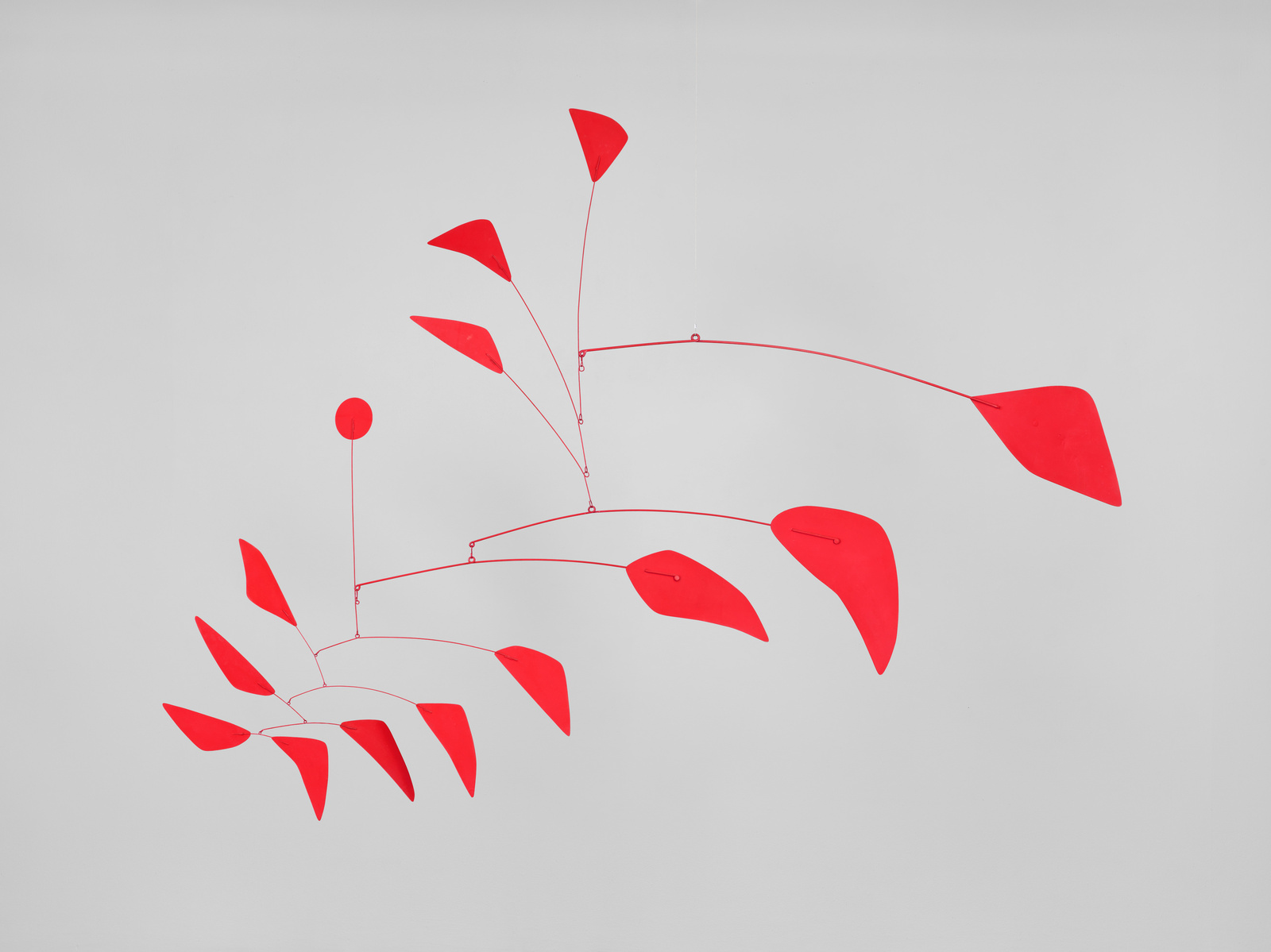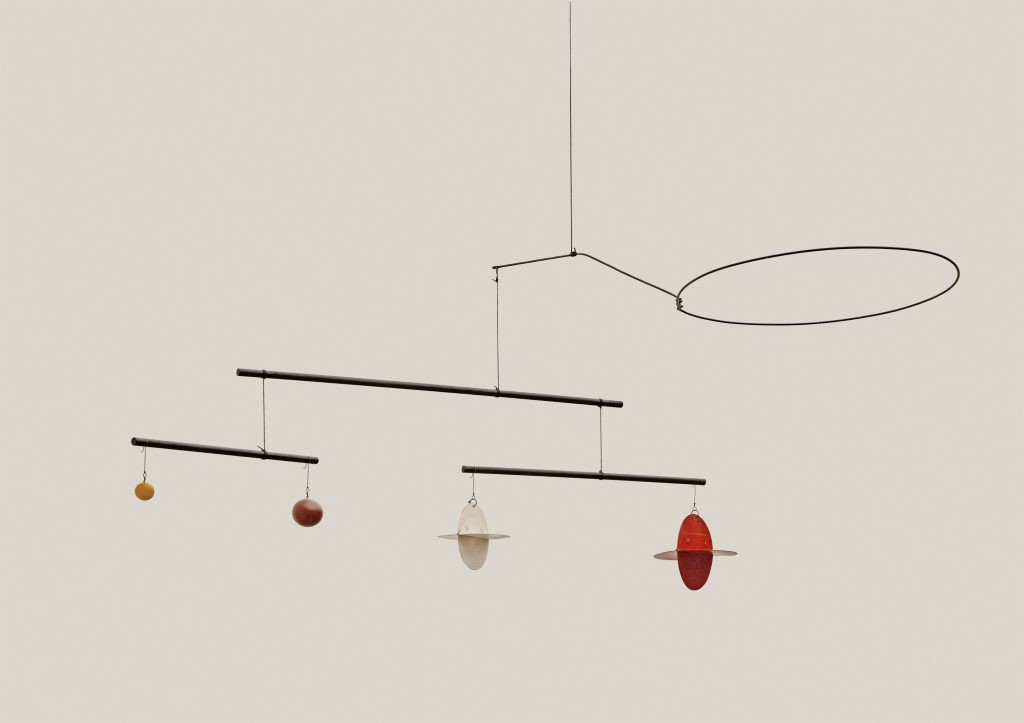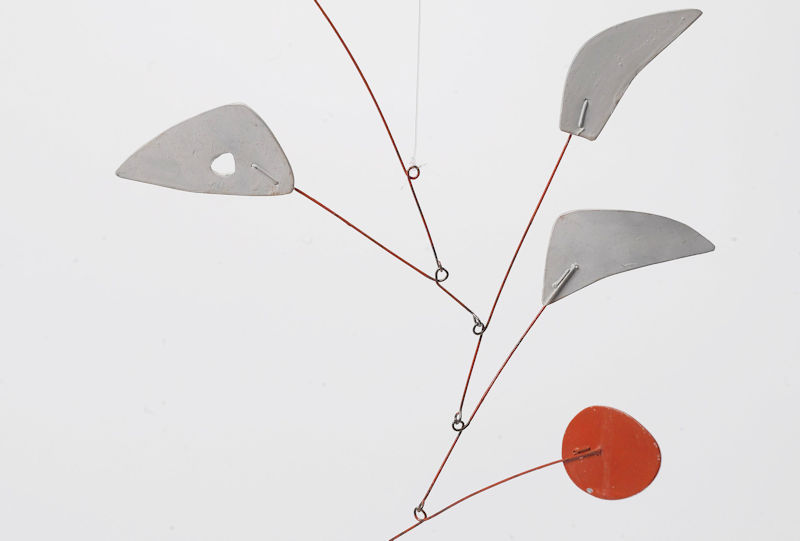For my final project, I’ve drawn significant inspiration from the work of Alexander Calder, one of the most prolific mobile makers of all time. His creations fall into the category of impressionist modern art, with his sculptures embodying quintessential modernism. Throughout his lifetime, he crafted thousands of kinetic sculptures and received astounding critical acclaim, with pieces ending up in places like the Guggenheim Museum and various other exhibits worldwide. I vividly remember seeing his mobiles in third grade, and they have stuck with me since then. At my elementary school, we participated in an activity called “Art in the Suitcase,” where parents would volunteer to teach art to students, dedicating the entire afternoon to delving deeply into the work of a specific artist. Afterwards, we were set free to create our own versions of their work. My attempt at Calder’s mobile during that time ended up being fully lopsided. This time, I hope to create one that’s more effective. Below is one of Calder’s most famous mobiles.



I want to utilize bright colors in the project, which I hope to achieve by using primer and spray paint on the aluminum panels that I’ve cut out using tin snips. By coating the wire attachments that lock the metal panes in place I hope to create the illusion of a seamless transition from panel to arm (benefited by the fact that the mobile will be hanging above the head of the audience out of range for scrutinization). I’m going to use 14 gauge wire to secure everything together as it has both appropriate rigidity levels while also being bendable enough to be easily manipulated to create the physical structure that I’m looking for. I plan to affix the individual ornaments to the bars with some back of the napkin calculations on the general lengths of the mobile beams, then moving the fulcrum of the mobile with my hands to eventually loop the wire back on itself to create a permanent fixture. I’m going to to use fishing line to connect the individual arms together and do overall assembly of the model. I may need to get 10 pound fishing line, and I may need to get a brief refresher of the knots that are secure with that type of cord.
One of the biggest challenges that I expect to run into is the center of mass of the beams shifting to create a slightly varied twist within the balance of the model. I’m worried that the orientation of the beams will be twisted out of my intended orientation because of shoddy craftsmanship on my end. I think the best way to achieve my intended design is to bend the beams to have a clear downturn, I expect that’s the reason for the clean bends Calder uses in the majority of his large ornament pieces. Another problem I expect to run into is the potential hanging problem. I don’t know if a simple command strip hook will be able to hold the entire weight of the mobile, I may need to invest into drywall anchors or another method to lock the model to the ceiling. A floor mounted stand may be another solution.
Initially I made a number of rough sketches but they all lacked the central theme that I found intriguing like the golden ratio. I think I’ve settled into a good idea that I can be genuinely proud of at the end of the semester. This isn’t a type of art that I’ve really tried before so I’m a bit nervous about messing up the project and then needing to present to the class a failed art project.
A lot of the art I had the opportunity to consume and be educated on throughout my life has been modern art or impressionist works of art. I know there sometimes is a narrative that abstract and modern art can be overly simple and lack some of the technical skills that are required to make “Traditional Art” but I am a firm believer in the ability to make an audience feel emotions and perceive certain ideas through abstract shapes and carefully constructed lines. Throughout the semester I’ve spoken in an almost neurotic level of depth about the implementation of the Bauhaus and it’s influences on modern aesthetics, I believe that this project really represents this idea: embodying the central design elements of the philosophy.
[1] https://whitney.org/collection/works/2826 [2] https://www.tate.org.uk/art/artists/alexander-calder-848/who-is-alexander-calder [3] https://calder.org/works/hanging-mobile/untitled-c-1937/ [4] https://calder.org/works/hanging-mobile/untitled-c-1942-7/ [5] https://www.marcomahler.com/wire-for-hanging-mobile/

 I plan to manufacture the project using aluminum sheeting that I cut using wire snips and then sand down to a rough finish. I then will punch the holes that I’ll use to attach the wires to the panels with a steel punch. Calder slightly bent the metal to create a dynamic look for the metal panels, looped the wire through the first hole, and then loops back to the main branch through the second hole. In essence the wire is locking the rotation of the metal sheets from rotating without requiring epoxy, welding, or another form of external bonding.The below image display this method:
I plan to manufacture the project using aluminum sheeting that I cut using wire snips and then sand down to a rough finish. I then will punch the holes that I’ll use to attach the wires to the panels with a steel punch. Calder slightly bent the metal to create a dynamic look for the metal panels, looped the wire through the first hole, and then loops back to the main branch through the second hole. In essence the wire is locking the rotation of the metal sheets from rotating without requiring epoxy, welding, or another form of external bonding.The below image display this method:
5 Comments. Leave new
Hello, I have been designing kinetic chaos engines for over 20 years. . Using air movement and electroluminescent magnetic installation. If any body is interested you can contact me a 585 615 4236 or Rogersonntag5@gmail.com always like to share. Some is at chaos engines chimes. Roger sonntag
I love how this idea blends science with art and is a fully functioning object while also portraying beauty. I believe that with your knowledge and experience you can grab from your research is going to allow you to make a beautifully performed final project. I’m so excited to see how this thing turns out!
Hey Andres, thanks for the support! I’m really hoping it turns out well.
Dear Trent,
Your latest project, which draws heavily on Alexander Calder’s kinetic sculptures, is a testament to your innovative spirit and deep appreciation for modernist art. You’ve managed to encapsulate the essence of Calder’s work, aiming to replicate the balance and elegance of his mobiles while introducing your unique perspective through meticulous planning and mathematical precision.
Your endeavor to capture the golden ratio in your design speaks volumes about your ambition to blend art with science. This echoes Calder’s own journey as an engineer turned artist. Your thoughtful approach, from selecting materials to calculating balance points, is commendable and reflects a deep commitment to authenticity and quality.
The challenges you anticipate, such as ensuring the stability of your mobile and achieving the desired aesthetic effect, are indeed significant. However, your methodical preparation and creative problem-solving strategies are your greatest assets. Your fascination with the Fibonacci sequence and its natural beauty, combined with your engineering background, positions you uniquely to tackle these challenges head-on.
In summary, your project not only pays homage to a legendary artist but also showcases your own creative and technical prowess. It’s clear you’ve poured your heart into this work, and I’m confident the final piece will be as impactful and mesmerizing as Calder’s own creations.
Best regards,
Jon
Hi Jon, thanks for the comment! I really appreciate you taking the time out of your day to write so much praise for my idea. It’s very thoughtful… hopefully my project can live up to the expectations.